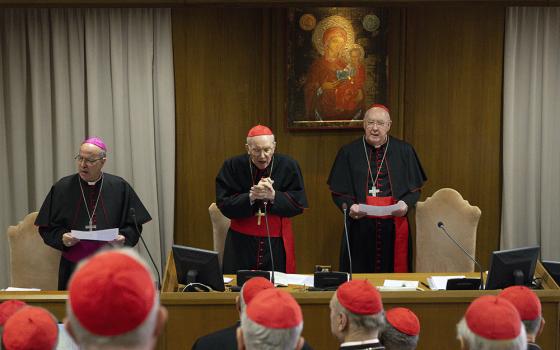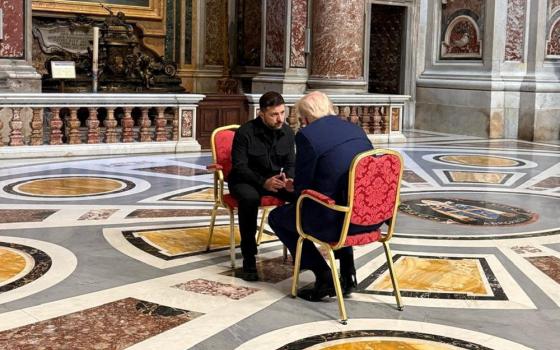Boston College has been ahead of the curve compared to most Catholic universities when it comes to understanding the increasing importance of the Hispanic presence in the U.S. church. When I got the list of events sponsored by the university's School of Theology and Ministry this semester, fully a third of the events were either in Spanish or focused on the Latino apostolate. So it is no surprise that BC has created an extensive, groundbreaking study of Hispanic ministry in Catholic parishes. Nor is it a surprise that the driving force behind the study was Professor Hosffman Ospino, a rising star in the Catholic theological firmament known to readers of this blog most recently for his exquisitely beautiful reflections on the U.S. bishops' Mass at the border, "Our Lampedusa," which was published by Catholics in Alliance for the Common Good in March.
The future of the Catholic Church in the U.S. is a largely Hispanic future. This is well-known if less well understood, and this report seeks to provide the data so that Church leaders have more than intuition upon which to make their plans and decisions. In 1980, Hispanics represented 25 percent of the U.S. Catholic population and 15 percent of all parishes served Hispanic populations. Now, Hispanics are 40 percent of U.S. Catholics and growing, and fully one-quarter of all parishes serve Hispanics. The influx of Hispanic and other immigrants comes as many dioceses are closing parishes, creating a pastoral tension and challenge. As the report notes, immigrants "often rely on parishes to remain connected to their religious roots and identity while they integrate into the larger society. Parishes matter" (emphasis in original). The report continues: "Parishes are among the first places Hispanic Catholic immigrants seek when searching for a familiar experience of community in a foreign land." The celebration of their faith is part of the "Hispanic cultural ethos."
There are now 29.7 million Hispanic Catholics in the United States, according to the Center for Advanced Research in the Apostolate (CARA). If the Church does not meet the needs of these Hispanic Catholics, they will be met elsewhere. A walk through my neighborhood permits one to encounter half a dozen storefront evangelical churches serving Hispanics, and there is always activity at these small enclaves of Christian faith. Fortunately, the local Catholic parish is also packed at most Spanish-language Masses, but still, one wonders if we had been more proactive in welcoming these immigrants, we might have kept those attending the storefront churches in the Catholic fold. According to the CARA data, 35.5 percent of all Catholic parishes serve a particular racial, ethnic, cultural and/or linguistic community other than Euro-Asian white Catholics, and 70 percent of these parishes serve Hispanics. The numbers are staggering.
The report focuses on four key themes:
1. Impact of the Hispanic presence in Catholic parochial dynamics, with particular attention to models of organization and strategies to better evangelize in the context of a culturally diverse church.
2. Leadership structures and needs to better support pastoral agents serving in Catholic parishes with Hispanic ministry.
3. Initiatives, commitments, and resources to advance faith formation among Hispanic Catholics at various age levels in parishes.
4. Diocesan structures supporting Hispanic ministry and the relationship of these structures with parishes with Hispanic ministry.
As these themes indicate, the report is concerned to provide a "state of the question" analysis before advancing proposals for improvement, mimicking the Holy Father's intention of making the forthcoming Synod of Bishops on the family an examination of the "state of the question" this year before moving on to next year's synod, which will consider what is to be done.
Before the authors of the report get to these four central issues, however, they first provide a useful historical analysis of Hispanic ministry in parishes. Too often, surveys forget this important step, forget to ask, "How did we get here?" and move too quickly to the question, "Where are we?" A few key aspects of this history are essential in understanding the different challenges faced by Hispanic ministry as well as illuminating some of the contortions and distortions that plague the national debate about Hispanics and immigration.
For example, the report reminds us that the very first parishes in what is now the United States were all Hispanic. Before the Hawk and the Dove arrived in Maryland bringing British Catholics to these shores, Catholic churches had been offering the sacraments for decades in what is now Texas, New Mexico, Arizona, California and Florida. The diocese of San Juan, Puerto Rico, was erected in 1513. Yet despite the fact that Hispanics were here first, the development of Hispanic parish ministry in the 20th century followed a different model, that of the national parishes for the Italians and the Polish and the Hungarians.
There is a major difference, however. "The European national parish was indeed for a 'nationality' ... " the report notes. "But a mixture of Catholics from the 21 nations in Latin America, without counting Spain and Puerto Rico, call the Hispanic parish home. The Hispanic parish has often been a place of encuentro for different nationalities making the name more appropriately 'Pan-Hispanic national parish.' "
The historical analysis also notes a very important post-World War II development, the emergence of a different model of ministry. "Sunday sermons and pastoral care were delivered to Spanish-speaking Catholics within existing parishes, often in the basement church. ... Hispanic communities by and large did not become clones of their Anglo counterparts but developed alongside these."
The book Puerto Rican and Cuban Catholics in the U.S., 1900-1965, edited by Jay Dolan and Jaime Vidal, related this history previously, and it is important. Cardinal Francis Spellman of New York was one of the first to break with the traditional national parish model for Latino immigrants. In the years after World War II, Spellman saw his European Catholic flocks heading to the suburbs, leaving behind large parish plants in the inner city. He did not want to leave his successors with a similar need to realign resources and structures and, so, avoided the national parish model. One can understand his reasoning, but one can also recognize that all people need a place they can call their own and that, over time, if that place is a basement, it says something about the priorities of the pastoral leaders.
The report also notes that in the 1960s, the combination of Vatican II reforms and political change intertwined in important ways. "A good number of priests, religious women, and lay leaders, Hispanic and non-Hispanic, in parishes serving Spanish-speaking Catholics across the country embraced the tools of community organizing and political advocacy to advance important social causes," the report states. PADRES and Las Hermanas are cited as examples. This was a time when parish leaders anticipated Pope Francis' call to acquire the smell of the sheep, and the sheep needed Mass, to be sure, but they also needed affordable housing, access to schools, transit systems that served poor, immigrant neighborhoods, health care, and a host of other material needs. It was out of this "smell of the sheep" encounter that D.C.'s own Centro Hispanico was born, begun by a newly ordained Capuchin friar, Sean O'Malley. Although in the late 19th century it did not have a name like "community organizing" and Saul Alinsky was not yet born, there were plenty of Irish and German pastors who were the de facto civic leaders of their communities as well.
O'Malley and other leaders in Hispanic ministry were also involved in the national "Encuentro" meetings in 1972, 1977, 1985 and 2000, at which Hispanic ministry strategies were discussed and debated by those who engaged in this ministry. The report notes that "parishes were at the heart of all the conversations and documents emerging from Encuentro." Again, it is interesting to see how this apostolate focused on a theme -- encuentro -- that has become a central motif in Pope Francis' discussions of the new evangelization.
With that historical background, the report moves on to consider what is going on at the parish level. I will take up that topic tomorrow.



